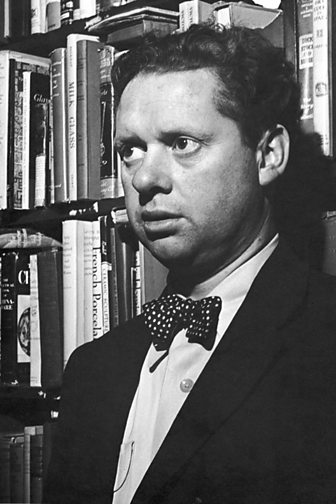Dylan Thomas: about the man
Dylan Marlais Thomas is perhaps Wales' best-known writer.
He wrote poems, short stories and scripts for film and radio, which he often performed himself. His public readings in America were highly acclaimed, and his mellifluous voice was celebrated in his numerous radio broadcasts.
Dylan Thomas' most celebrated works include Under Milk Wood, Do Not Go Gentle Into That Good Night, Fern Hill and A Child's Christmas In Wales.
Early years
Dylan Thomas' early years shaped him, both as a person and as a writer.
He was born on 27 October 1914 at 5 Cwmdonkin Drive in Swansea, a newly built semi-detached house his parents had bought earlier that year.
The family – his father David John Thomas, known to all as DJ, his mother Florence, the young Dylan and his sister Nancy, eight years his elder - lived in the Uplands suburb of Swansea. It was a respectable area overlooking Swansea bay and the town.
Dylan Thomas' parents both spoke Welsh and had strong links to Welsh cultures and customs, but brought up their children to speak only English. This was something quite usual in this largely Anglicised area.
Both Nancy and Dylan were sent to elocution lessons, to which the poet later attributed his 'cut-glass' accent.
As a boy, Dylan almost exclusively knew the western suburbs of Swansea, particularly nearby Cwmdonkin Park. But his childhood summers were mostly spent at Florence's sister Ann's dairy farm in Carmarthenshire. These holidays would later inspire the poem Fern Hill, published in 1946.
In 1925, just before his 11th birthday, Dylan began attending Swansea Grammar School, where his father had been teaching for two decades. DJ was in charge of the school magazine, and his son immediately began submitting material for publication. It was a matter of weeks before his first poem was published.
The writer
At school, the only subject in which he excelled was English. But as an unruly child, he was undisciplined and mostly underachieving. In 1931 he left school, and got a job as a reporter for the South Wales Evening Post. He was not wholly successful, and was eventually sacked though he continued working as a freelance journalist sporadically for several more years.
In 1933 his poetry began to receive greater exposure. He was published in periodicals, and a submission to a 91�ȱ� poetry competition resulted in it being read on air.
The following year he moved to London, where his first poetry collection, 18 Poems was praised by a number of established poets including Edith Sitwell. Yet he was steadily acquiring a reputation as a bit of a drinker.
The main themes of Dylan Thomas' poetry were nostalgia, life, death, and lost innocence. He wrote often about his past as a boy or as a young man. And Wales, and the Welsh landscapes and people, became an integral part of his writing.
Family life
Dylan married Caitlin Macnamara in 1937. In 1938, as she and Dylan settled in to life at Sea View in Laugharne, Caitlin fell pregnant. She gave birth in January 1939 to their first child, Llewelyn, in Poole, Dorset.
They had a volatile relationship. Both Dylan and Caitlin had affairs throughout their marriage, and each resented the other's while excusing their own behaviour.
In March 1943 the couple's daughter, Aeronwy, was born in London. She was named after the River Aeron, which flows through Cardiganshire.
Six years later, when the Thomas family had settled in Laugharne in 1949, Caitlin was expecting their third child. Colm Garan Thomas was born that July.
America
Dylan’s first trip to America in 1950 was in part determined by money. His poems were being published there, and he had a considerable stateside following.
The poet John Malcolm Brinnin was an admirer of Dylan's writing, and invited him to give readings at the Poetry Center at New York's Young Men's and Young Women's Hebrew Association.
While it may have made him money, America did little to inspire Dylan's writing - he made few references to it in his writing. He did, however, take to the many bars and parties he was taken to.
He made four trips to America. On 19 October 1953 he arrived for the last time, alone, in New York. He began drinking heavily, and was unable to stop vomiting during a rehearsal of Under Milk Wood. A doctor, Milton Feltenstein, treated him.
The line, “I've had 18 straight whiskies. I think that's the record" has become part of the Dylan Thomas legend but there has been subsequent discussion about the role of alcohol in his demise.
Dylan Thomas died at noon on Monday 9 November 1953. The post mortem gave the primary cause of death as pneumonia, with pressure on the brain and a fatty liver given as contributing factors. He is buried at St Martin's Church in Laugharne.
Thomas left little money and had made no will. It was a messy end, but one curiously befitting for the romanticised poetic lifestyle he had sought for so long.

-
![]()
A gallery of images from throughout Thomas' lifetime.
-
![]()
Owen Sheers and Richard Harrington present two new Guides.



